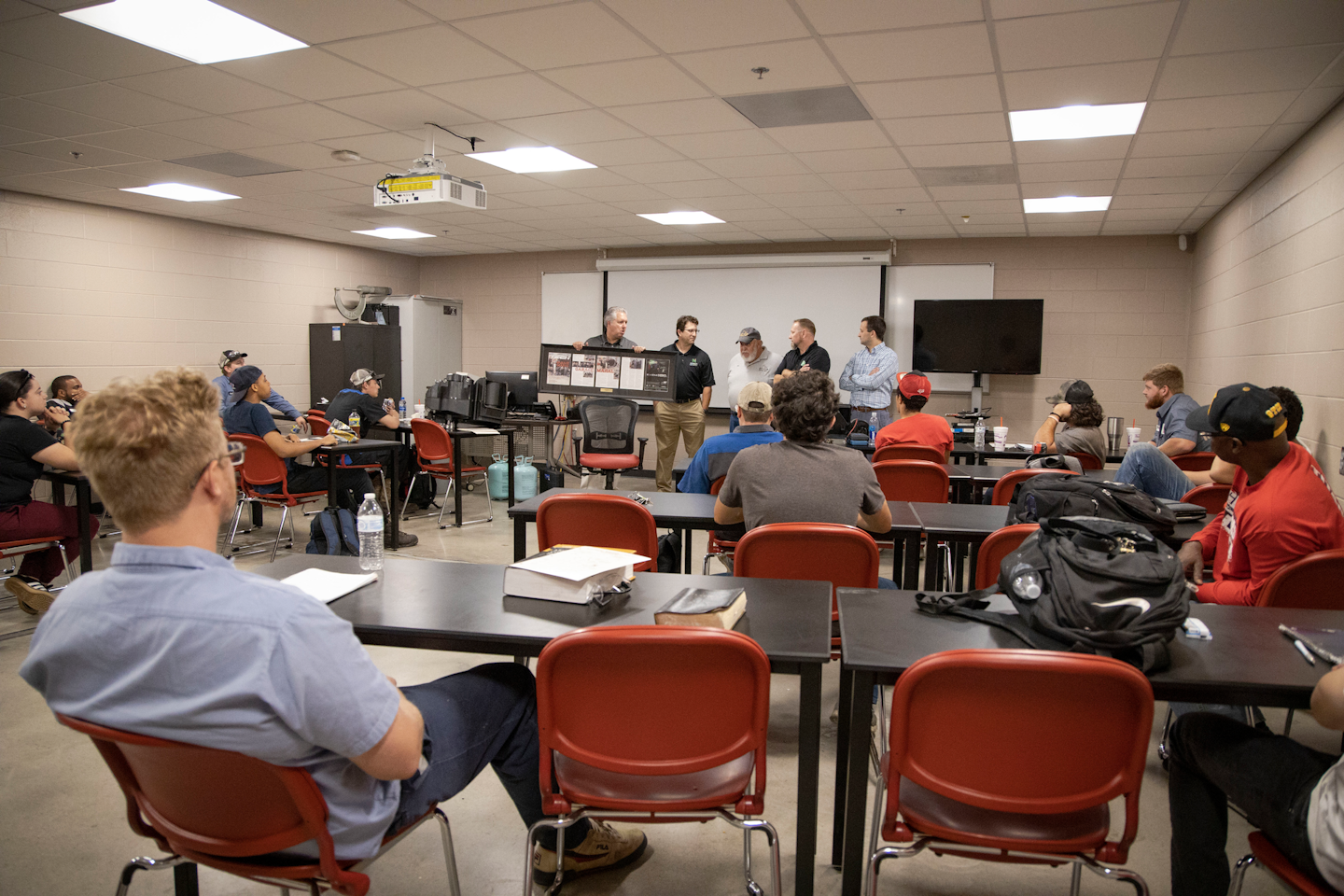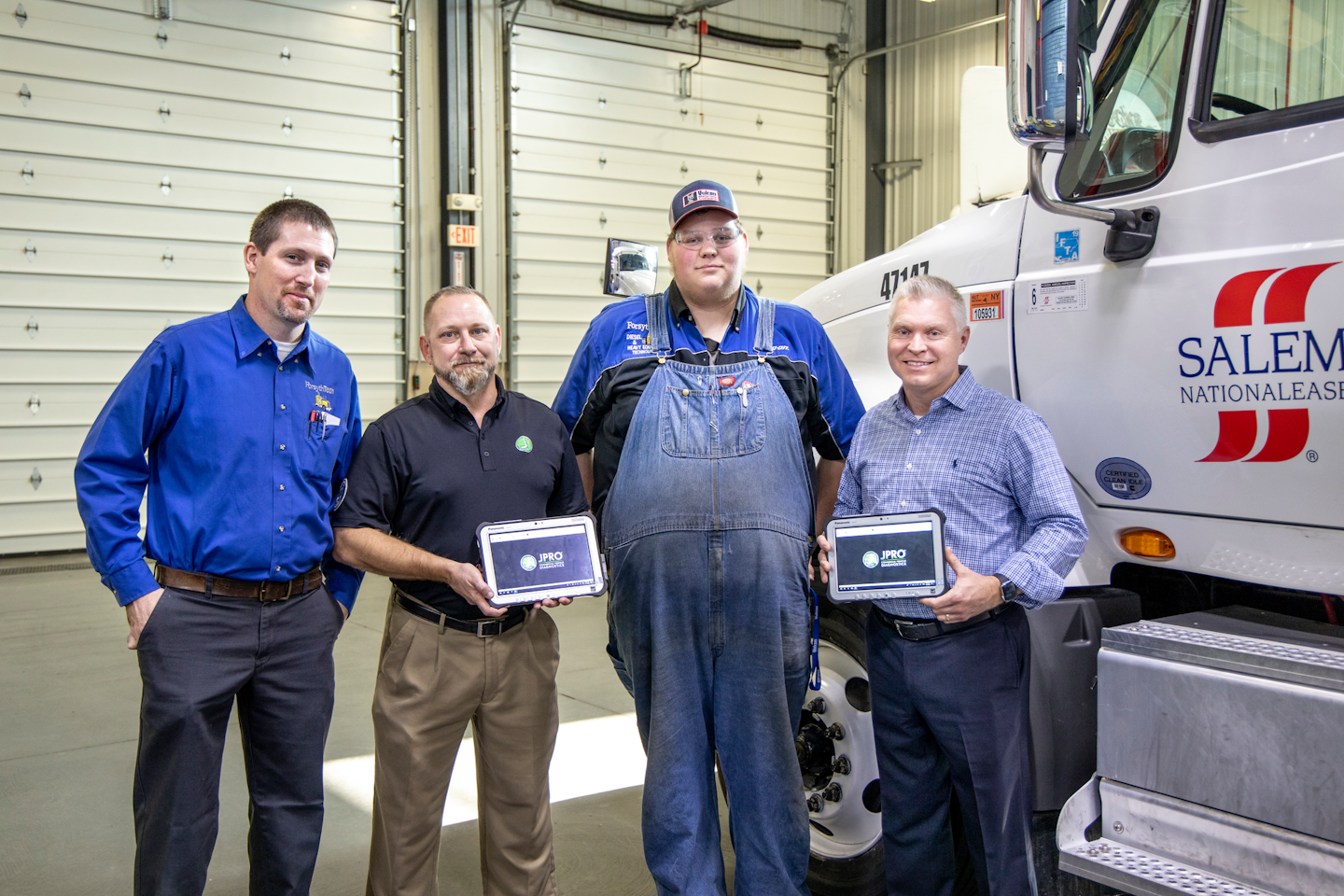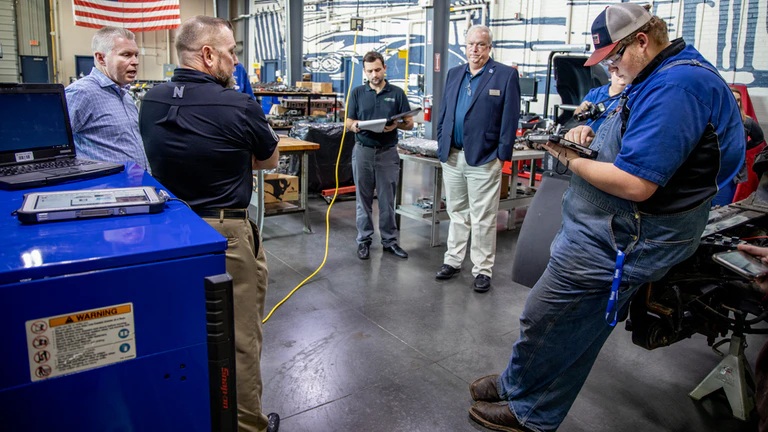Implementing apprenticeship programs in fleet maintenance operations can serve to raise the qualifications and experience level of new technicians entering the workforce.
The industry’s shortage of qualified technicians is top of mind for most fleet maintenance operations. Finding and recruiting qualified, experienced technicians has become a daunting process, so many have increasingly turned to a fresher segment of the workforce: students and recent graduates. In order to successfully recruit, hire, and retain young technicians, it is important to have a mentorship program in place that will assist the transition from student to full-time employee.
Mentorships, apprenticeships, and internships all provide opportunity to raise the bar of a graduate’s qualifications. However, the implementation and execution of such a program, especially a successful one, can be a challenge. Creating a successful mentorship relationship for students and recent graduates helps new technicians gain the technical skills the industry demands of its future workforce.
TMC’s Technician Apprenticeship Standards
The American Trucking Association’s Technology & Maintenance Council (TMC) formed the Technician Apprenticeship Standards Task Force to establish industry guidelines when implementing apprenticeship programs into fleet maintenance operations. The task force was formed to help standardize these programs in an effort to help streamline the process of on-the-job technician training.
“In a 2020 Supply and Demand Report from the Tech Force Foundation, it said that by between 2020 and 2024, there was going to be a need for 400,000 automotive technicians,” says Arica Jackson, automotive specialist at UPS and the TMC Technician Apprenticeship Standards Task Force Chair. “The goal is to help with that need.”
“The Apprenticeship Standards also make sure there is a qualified bench,” Jackson adds. “It would be a shame if we get so tight as an industry that we are just looking for warm bodies. Men and women are riding on our work, so wanting to keep the quality of the industry up is the reason why the apprenticeship chambers are so important. It creates a bench of new technicians that are looking for a career, but also makes the industry better so that it isn’t just a warm body being thrown into a shop.”
The trucking and automotive industries are not alone in turning to apprenticeships as a solution to the need for qualified applicants.
President Donald Trump signed the executive order (EO) “Establishing Industry-Recognized Apprenticeships” in June of 2017 to promote the development of third-party apprenticeship programs.
As part of that EO, in May 2018, the Task Force on Apprenticeship produced its final report providing recommendations on establishing Industry-Recognized Apprenticeship Programs (IRAPs), designed to provide organizations more tools to create quality apprenticeship programs. The U.S. Department of Labor issued a final 300-page rule that established a system for advancing the development of high-quality IRAPs.
“It was really important that this task force produced something that could be used whether you have half a million employees or you are mom-and-pop vendors so that everyone can have this opportunity no matter where you stand, because everybody’s hurting [and] everybody needs technicians,” says Jackson of the TMC Technician Apprenticeship Standards. “A lot of companies don’t have the ability to read that 300-page document.”
The task force sought a way to take the 300-page ruling and make it into something that anybody could pick up and use immediately to help their shop and their company without sacrificing quality, Jackson explains.
“You don’t want a situation where a technician [apprentice] is just a ‘check the box’ situation, because it’s not fair to the apprentice, they’re not getting quality [training], and safety-wise, you don’t want anyone getting hurt,” Jackson says. Launched in March 2019, the Noregon Education Program is now nationwide with nearly 40 participating schools. The Education Program provides students with the technology and resources used in the industry today.Photo courtesy of Noregon Systems
Launched in March 2019, the Noregon Education Program is now nationwide with nearly 40 participating schools. The Education Program provides students with the technology and resources used in the industry today.Photo courtesy of Noregon Systems
As part of the collaborative development of the standards, George Arrants, vice president of the ASE Education Foundation, recommended the task force fold in like-parameters of a previous industry internship program called the Automotive Youth Education Systems (AYES).
“What we’re doing is taking what we learned in AYES and we’re trying to bring the intern/mentor training up to the 21st century,” Arrants says.
The AYES initiative worked with high school programs that met national accreditation requirements to create internships, Arrants explains.
The AYES program worked to educate junior year high school students throughout the school year on industry employment opportunities. Between the students’ junior and senior year, students would participate in a paid summer internship with a workplace mentor at a local participating dealership. After an evaluation at the end of the summer, if the student did well and was interested, they could work part-time at the shop with their mentor throughout the senior year.
“At the time of graduation, they would either go full-time in the dealership or go on to that dealer’s specific manufacturer training program at a local community college,” Arrants notes.
The standards for the TMC apprenticeship program are still under development but are planned to be made available to TMC member companies for free at the upcoming annual meeting later this year, Jackson says. The standards will be presented as a TMC Recommended Practice (RP) which will include an outline for implementing an apprenticeship program into fleet maintenance operations.
Included in the standards will be parameters such as a work process schedule, instruction outlines, an application for the apprentice, minimum qualifications, an employer acceptance agreement, and more. There is also a calendar which includes a “check-off list,” Jackson explains, which serves as a monthly record to track an apprentice’s progress to help ensure they are gaining valuable experience and not being pigeonholed into select tasks.
The mentor
Both Jackson and Arrants agree that the lynchpin of a successful apprenticeship program is the mentor.
“The first thing you have to realize as an employer is whether your facility is ready to take on an intern or an apprentice,” Arrants says. “If your shop is caustic and the environment is caustic, there’s no reason to bring on a young individual that is excited about this career, because you’re just going to eat them alive and spit them out.”
You have to make sure that your facility and your organization are ready and able to take that individual, Arrants adds. If it is, the most difficult and important decision you will have to make is who is going to be that mentor.
“The most important part is to have somebody who is mentor material,” Jackson says.
She explains that the TMC Technician Apprenticeship Standards also include details on what makes a good mentor.
Selecting who will be the mentor is a crucial decision and arguably the most important piece in establishing a successful mentorship program. The decision should come from more than a technician’s proficiency in maintenance tasks, but also their ability to navigate the shop in more ways than turning the wrench.
“They’ve got to like working with young people,” Arrants states. “If they’re already in scouting, or they’re in Little League, or they’re in a church group, those are the types of people who already like working with youth.”
Working with younger employees, the mentor has a critical role. “The mentor is to guide the intern through the maze of minutia that goes on in that shop,” Arrants adds. “At the same time, when they’re doing their hands-on [work], they want to make sure that they provide constructive criticism and oversight as they start to develop in those skills.” With a limited pool of qualified experienced technicians, apprenticeship programs offer the industry the opportunity to create a pool of better-qualified applicants.Photo courtesy of Noregon Systems
With a limited pool of qualified experienced technicians, apprenticeship programs offer the industry the opportunity to create a pool of better-qualified applicants.Photo courtesy of Noregon Systems
For many interns or apprentices, it can be their first experience in a real-world shop environment or even their first experience with employment. A mentor will have to not only advise on the technical aspects of the job, but also on the intricacies of being an employee.
“If you don’t have the personality and the character traits to mentor somebody, it doesn’t matter how great of a technician you are,” Arrants explains. “A lot of times, people think, ‘We should put our best technician with the intern.’ Don’t ever do that. You want the middle-of-the-road guy or gal. You want somebody who’s in the shop that does a good job; maybe they’re not recognized for a lot of things, but they do good work. They have good work habits and they like working with others. The guy that you don’t want anybody talking to until 3:30 on Tuesday afternoon after he’s had two pots of coffee, that’s not your mentor. And more importantly, your mentor has got to protect your intern or your apprentice from that guy.”
Engaging an apprenticeship
After establishing that your operation is ready to take on an apprentice and selecting the technician on your team who is most fit to serve as a mentor, the next step is securing an apprentice.
Jackson explains that the TMC Technician Apprentice Standards includes an amendment which serves as a high-level overview of how to reach out to schools and get the process started. This includes how to talk with local high schools, who to reach out to, and industry resources that have already done the legwork that can assist in connecting with technician education programs.
“Don’t just show up on career fair day and expect all the kids to come running to you,” Arrants advises. “You’ve got to build your relationship with the students in the school. Maybe you come in as a guest speaker, maybe have the students and the instructors do a field trip to your place of business.”
Arrants also acknowledges that with the current state of reality due to the COVID-19 pandemic, a scenario has been created in which virtual platforms expand the reach of a business’ recruitment efforts.
“You can start building your relationship with the school virtually,” Arrants says. “You could be a guest speaker from 2,000 miles away … Since many of the schools are still virtual, their advisory committee meetings are virtual. You can get your feet wet by learning what’s going on with the school without leaving your office.”
An important aspect to consider is that an apprenticeship program is established through relationship building. Building a relationship with technician education programs will only bolster the recruitment efforts a fleet makes in obtaining an apprentice.
Education and expectations
Bringing an apprentice into a fleet’s maintenance operation is very different from hiring an experienced technician. One thing that remains the same, however, is that expectations need to be set and made clear for everyone involved. In an apprenticeship, that means communication and transparency with the maintenance team, the mentor, and the apprentice.
“The big problem is industry is not involved in education and education isn’t teaching what industry needs,” Arrants says. “Education is still teaching engines. And you and I both know there’s not a company that’s going to put a 19-year-old on a $60,000 engine.”
Arrants says schools are often not focusing on areas such as preventive maintenance inspections or trailers. Expectations need to be managed so that if employers are hiring young people or graduates from these schools, they know what’s being taught so they can measure the student against what they should know, not what the employer thinks they should know.
Though a gap may exist in technician education and real-world demand, the gap is narrowing thanks to advances in technologies available to students and programs such as Noregon’s Education Program.
“We work with post-high school institutions that have diesel programs to provide them diagnostic software resources,” explains Ali Kirsten, channel marketing manager at Noregon. Schools enrolled in Noregon’s Education Program receive:
- Free JPRO and NextStep software
- Discounts for any hardware purchased
- Demonstration licenses for each student through JPRO Virtual Truck
- Graduation packages including one year free of JPRO and NextStep software and discounts for additional software and hardware
- JPRO certification
- Scholarship opportunities
Launched in March 2019, the Noregon Education Program is now nationwide with nearly 40 participating schools. The Education Program provides students with the technology and resources used in the industry today. Programs like this can help more clearly establish the expectations of both graduates and employers as to what the shop demands and the capabilities of those entering the field. Furthermore, the Education Program is shifting the diesel technician curriculum.
“We are taking it one step further,” says Bill Alday, fleet trainer, Noregon. “We are going in and teaching classes, training the instructors on how the curriculum could be laid out with JPRO involved. It could be brakes, it could be engine diagnostics, preventive maintenance … It is far reaching.”
And the capabilities of such software not only facilitate the curriculum material, but also provide flexibility in the curriculum’s implementation.
Alday explains that the curriculum can be adjusted to handle remote learning common in today’s learning institutions. Utilizing JPRO, instructors could bug a truck in the lab, create a log file, and allow students access to diagnose and work on the truck remotely.
The training provided, Kirsten explains, allows instructors to teach the vast capabilities of JPRO and simultaneously place real-world applications in the hands of the students.
Through the availability of technologies and resources in the educational stage, the industry can build a new standard as to the capability and proficiency expectations of recent graduates.Photo courtesy of Noregon Systems
Jason Hedman, product manager with Noregon, explains that one of the driving forces behind the Education Program is to combat the technician shortage across the industry.
“[This is] one way to get people qualified,” he says. “Get this software in their hands as early as possible and get them to use it as early as possible.”
Through the availability of such technology and resources in the educational stage, the industry can build a new standard as to the capability and proficiency expectations of recent graduates. Hedman advises these training opportunities are designed to teach students to get comfortable using tools like Virtual Truck.
“In most shops, there’s one or two people that everybody goes to that is the ‘computer guy.’ We’re trying to change that,” Hedman says. “We want everybody to be the computer guy. More time is being spent in the diagnostic applications now than ever before and we need to be comfortable in those applications to fix these trucks.”
Virtual Truck allows students, or technicians in general, to get comfortable using the application as it would be in the real world. “You have got to be actively engaged in the diagnostics on the truck and how to use those diagnostic tools,” Hedman says.
The opportunity to raise the expectations and capabilities of recent graduates is further reinforced through the Education Program’s offering of JPRO certification.
“The certification process is designed along the lines of an ASE certification,” Hedman explains. “[Certified students] receive a certificate to take with them to their potential job, showing that, ‘Hey, I’ve not only been exposed to JPRO, but I am certified to use the product, know how to use the product, and I demonstrated a level of expertise that gives me this certification and I’m ready to go to work for you.’”
There will always exist the need to recruit, hire, and retain new employees in a fleet’s maintenance operation. With a limited pool of qualified experienced technicians, apprenticeship programs offer the industry the opportunity to create a pool of better-qualified applicants. Allowing students and recent graduates to work alongside industry professionals and gain real-world experience should serve to raise the standard of graduates’ qualifications, capabilities, and proficiencies. As organizations like TMC form standards that the industry can follow and implement, a new pool of young applicants will be created having further experience than those before them.
“The whole world is watching us now because of the pandemic,” UPS’s Jackson says. “I feel like for so long, this industry was in the shadows, and so we need to use this attention. It won’t be on us forever. People will walk away; they’ll forget all that we did during this time. We have the attention, now is the time to use it to draw people in. Every other industry does this, people promote being a doctor, or promote being a nurse – we need to promote this industry.”
Source: https://www.fleetmaintenance.com
CUT COTS OF THE FLEET WITH OUR AUDIT PROGRAM
 The audit is a key tool to know the overall status and provide the analysis, the assessment, the advice, the suggestions and the actions to take in order to cut costs and increase the efficiency and efficacy of the fleet. We propose the following fleet management audit.
The audit is a key tool to know the overall status and provide the analysis, the assessment, the advice, the suggestions and the actions to take in order to cut costs and increase the efficiency and efficacy of the fleet. We propose the following fleet management audit.



